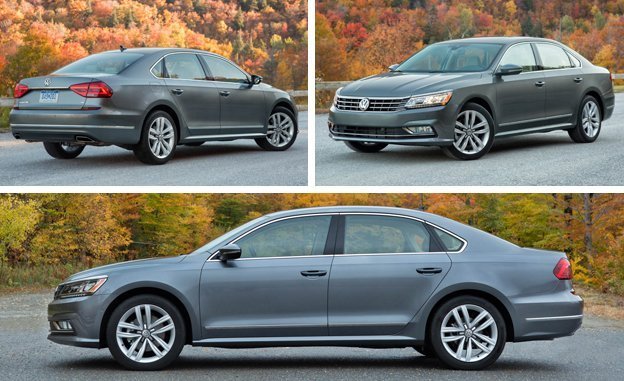The Passat has been part of Volkswagen’s U.S. product program since the early 1970s. It started life here as the Dasher in 1974, back when the company began to wean itself from its Beetle-only roots, before evolving into the Quantum in the mid-1980s and then the Passat in 1990.
Over six generations, there have been sedan and wagon body styles, but none have been particularly successful in competing with the likes of the Toyota Camry and the Honda Accord for sales. Still, they were solidly Teutonic in character, and if buyers were few, they were fervent in their affection and loyalty.
The seventh generation that made its debut in 2012 represented a departure—a U.S.-market version that’s bigger than its European cousin, quieter than many of its competitors, and possessing a character that VW product planners (who are located in Wolfsburg, Germany, and often seem confused about our market) see as perfect for American drivers. Translation: Decades of autobahn development have been slightly muffled in the quest to grab a bigger share of the massive mid-size-sedan segment here. VW was being outsold by bigger, softer-riding cars, so it gave us a bigger, softer-riding Passat. And this 2016 freshening doesn’t really do anything to mitigate the departure from the model’s former Audi-on-a-budget appeal.
Dynamic Presence?
The Volkswagen brand has rarely been noted for adventurous design, and the Passat is true to that restrained tradition. Yet there is much that’s new on the 2016 model. All the surfaces from the windshield forward have been redesigned. The new four-bar grille is more assertive, the new hood is slightly domed, there’s more bright trim, and the lighting array now includes the option of LED headlights, fog lights, and taillights. The bumpers are also new, as are the trunklid and the redesigned selection of wheels in 16- to 19-inch sizes. VW design chief Klaus Bischoff says the styling updates add up to “a dynamic presence and a more sophisticated look.” Let’s call it subdued dynamism; this is still basically a conservative design, but the 2016 Passat does have a more upscale presence than the 2012–2015 car.
The interior has been refreshed, too, with some particularly tasteful simulated wood trim and nice-feeling leather on the steering wheel of our test car. Beyond that, the infotainment has been enhanced, and safety updates have strengthened the Passat’s ratings with the National Highway Traffic Safety Administration (which gave it five stars) and the Insurance Institute for Highway Safety (which named it a 2016 Top Safety Pick +). But the car’s real strong suits continue to be that it’s built on an exceptionally solid structure, the build quality is excellent, and it has the roominess that American buyers expect in a family sedan.
Our test car had VW’s 3.6-liter V-6 engine coupled to its appealing six-speed dual-clutch automatic transmission. (VW offered a six-speed manual transmission on the Passat with the 2.0-liter TDI turbo-diesel four-cylinder, the sale of which has been put on an indefinite—perhaps permanent—suspension due to the company’s emissions-cheating scandal.) One of the better achievements of the Ferdinand Piëch era at Volkswagen AG, the narrow-angle V-6—10.6 degrees between the banks, with a common cylinder head serving both—delivers plenty of smooth power as well as advantages in packaging. The engine, which was introduced in 1991 and is known as the VR6, would be even better if it were lighter; VW prefers iron blocks for the six and for the standard 1.8-liter turbo four. Nevertheless, the V-6 delivers brisk acceleration: zero to 60 mph in 5.7 seconds, which is at the top of the charts among mid-size sedans. This Passat outruns six-cylinder versions of the Honda Accord sedan and the Toyota Camry by a tenth of a second to 60 mph. One to watch in this department, however, is Ford’s 325-hp, twin-turbo V-6 Fusion Sport, which we have yet to test.
The accelerative advantage is reflected in so-so EPA fuel-economy ratings of 20 mpg city and 28 mpg highway. We recorded 24 mpg in mixed city and highway driving during our test, the same as we observed with the Camry V-6 and 3 mpg better than our test of the Accord V-6. Six-cylinder engines are becoming rare as automakers develop more fuel-efficient turbocharged fours, so the VR6’s days are clearly numbered.
The Comfort Priority
It’s true that this made-for-and-in-America model of the Passat is a little softer and heftier than its European counterpart, something that has provoked a bit of disdain by some of our resident hotshoes. But not every car has to be a track star; this is a family sedan, after all. Ride quality is supple, and although there’s a little more body roll than you’d get in, say, a BMW 3-series, it still feels taut and controlled in comparison with most family sedans. If its autobahn heritage has been tempered, the Passat continues to display the kind of stability required for sustained running at 120 mph.
The Passat’s responses in quick maneuvers are prompt; braking performance is consistent with other cars in this class, if no longer outstanding (it is notably free of any trace of fade, however); and interior noise is low at all speeds. The transmission is all but indistinguishable from a traditional torque-converter automatic in the way it goes about routine business, excepting its less prompt tip-in response from rest, but in its sport mode or when the driver takes control via the Tiptronic lever, it delivers exceptionally crisp shifts. About the only dynamic element that could use some work is the electric power steering, which still feels vague and overassisted below about 50 mph, although many contemporary sedans leave the same impression. In the main, the Passat is satisfying to drive, inspiring confidence as the miles accumulate and providing comfort in any run, short or long.
Value Factor
In terms of style, quality, comfort, dynamics, and value, the 2016 Passat stacks up with the best in a class that’s loaded with good cars. It’s exceptionally roomy—both in the front and especially in the rear seats—it has top safety ratings, and there remains that hint of German genetics in its sinews that a driver can appreciate.
At $37,655, the SEL V-6 is one of the most expensive sedans in its class. But the SEL is the only trim that will net you the six-cylinder, and it includes pretty much every comfort or convenience item in the Passat inventory. Our test example had no optional equipment but included as standard a 6.3-inch touchscreen with navigation, adaptive cruise control, forward-collision alert with automated emergency braking, park distance control with a rearview camera, park assist, lane-departure warning, blind-spot monitoring and rear-traffic alert, a proximity key and remote start, Fender premium audio, what VW calls its Car-Net features (which include Apple CarPlay and Android Auto), and an available subscription to emergency access, remote access, and “vehicle health” services. It also had leather seating surfaces for the heated front and rear seats, power-adjustable front lumbar supports, dual-zone automatic climate control, a hands-free trunk-opening function, rain-sensing wipers with heated washer nozzles, a power sunroof, power-folding heated side mirrors, and so on.
The term “sports sedan” may not apply here, but in this full-featured spec, the Passat offers more room and comfort than the similarly priced entry-level Audi A4 2.0T and comes near enough to matching its performance ability—at least in circumstances when the Audi’s Quattro all-wheel-drive system doesn’t matter—to satisfy most family-sedan buyers. Even though we’d probably prefer to drive an Audi if we were alone, the Passat is some distance from passé. Think of it as the automotive equivalent of an excellent German recipe baked in an American kitchen.
Powered by WPeMatico






